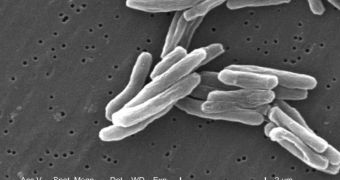At one point in our history, a diagnostic of tuberculosis (TB) equaled certain death. With the advent of antibiotics, treating the devastating condition became possible, and some experts were even confident that eradication was a real possibility. But unfortunately, the microorganism causing the disease, called Mycobacterium tuberculosis, adapted and became drug-resistant. Furthermore, it “allied” itself with HIV to create a deadly synergy, which now claims increasing numbers of lives each year. But their rampage may again be at an end, as researchers devise a new way to kill it, AlphaGalileo reports.
In fact, the team behind the study says, it's not so much that the new drug kills the bacteria directly as it is that it tricks the pathogen into ending its own life. The newly-discovered class of drugs makes M. tuberculosis start a cascade of chemical reactions that eventually lead to the bacteria poisoning themselves.
“With the advent of antibiotics, TB became treatable and at one point eradication was believed possible. But TB has re-emerged as a major global health threat due to poverty, a deadly synergy with HIV and the emergence of drug resistant strains that are virtually [impossible to cure] with current therapies.” explains John Innes Center expert Dr Steph Bornemann. He adds that current statistics put the death toll on TB-related victims to about 2 million people each year. This makes tuberculosis the leading cause of global deaths from bacterial infections.
Two research teams, the British one at the Center and colleagues at the Yeshiva University Albert Einstein College of Medicine, in the United States, reached the new pathway of attack independent from each other, by using different methods. They found that an enzyme called GlgE played an important part in the TB cells, by clearing them of a modified sugar called maltose 1-phosphate (M1P). If the enzyme's actions are inhibited, then M1P concentrations spike, and the cells start producing even more of the sugar in an extremely-misguided stress response. The toxin accumulates inside the cell until it finally shuts down its functions, destroying it.
“This pathway has never previously been targeted by antimicrobials and offers a treatment option very different from antibiotics in use,” explains Albert Einstein College of Medicine research scientist Dr William Jacobs, Jr., who was also the senior and corresponding author of the new study accompanying the findings. The research was supported with money secured from the Biotechnology and Biological Sciences Research Council (BBSRC).

 14 DAY TRIAL //
14 DAY TRIAL //